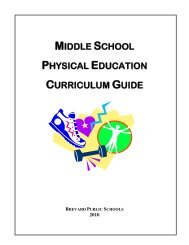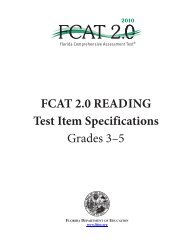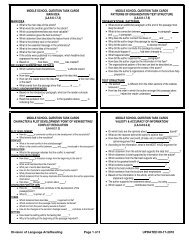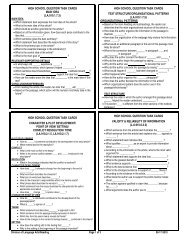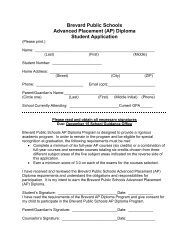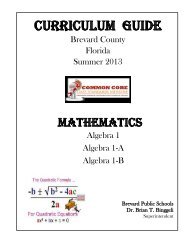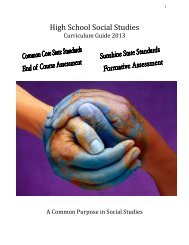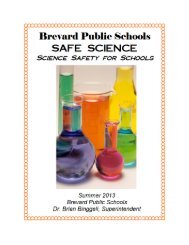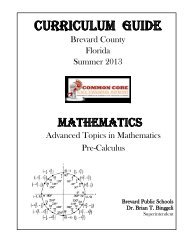Science Research Program Guide - Secondary Programs Home ...
Science Research Program Guide - Secondary Programs Home ...
Science Research Program Guide - Secondary Programs Home ...
Create successful ePaper yourself
Turn your PDF publications into a flip-book with our unique Google optimized e-Paper software.
6) <strong>Research</strong> conducted by a pre-college student at federally<br />
regulated research institutions (e.g., universities, medical<br />
centers, NIH, correctional institutions, etc.) must be<br />
reviewed and approved by that institution’s IRB. A copy of<br />
the IRB approval for the entire project (which must include<br />
the research procedures/measures the student is using) or<br />
an official letter from the IRB attesting to this approval is<br />
required. A letter from the mentor is not sufficient<br />
documentation of IRB review and approval.<br />
7) A student may observe and collect data for analysis of<br />
medical procedures and medication administration only<br />
under the direct supervision of a qualified professional.<br />
The qualified professional must be named in the research<br />
protocol to be specifically approved by the IRB. Students<br />
are prohibited from administering medications and performing<br />
invasive medical procedures on human subjects. The<br />
IRB must confirm that the student is not violating the<br />
medical practice act of the particular state or nation in which<br />
he/she is conducting the research.<br />
8) Student researchers may NOT publish or display<br />
information in a report that identifies the human subjects<br />
directly or through identifiers linked to the subjects,<br />
(including photographs), without written consent. (Public<br />
Health Service Act, 42, USC 241 (d)).<br />
9) All standardized tests that are not in the public domain<br />
must be administered, scored and interpreted by a Qualified<br />
Scientist as required by the instrument publisher. Any and<br />
all use and distribution of the test must be in accordance<br />
with the publisher’s requirements including procurement of<br />
legal copies of the instrument.<br />
10) Studies that collect data via use of the internet (e.g., email,<br />
web based surveys) require special consideration from the<br />
IRB which should have at least one member with<br />
professional expertise in conducting human subjects<br />
research. The use of the internet and email for data<br />
collection will pose challenges in a) collecting anonymous<br />
data, b) obtaining informed consent and c) ensuring that<br />
participants are of the appropriate age to give informed<br />
consent. The research plan and Form 4 must explicitly<br />
address how these challenges were evaluated and<br />
addressed.<br />
It is permissible to develop a process of obtaining informed<br />
consent that is conducive to internet research. <strong>Research</strong>ers<br />
will want to provide information to potential participants<br />
about the purpose of the study and nature of their<br />
participation, potential risks, the voluntary nature of the<br />
study and the participant’s right to withdrawal from the<br />
study at any time. A sample informed consent statement for<br />
adult participants is available on the web at<br />
www.societyforscience.org/isef/document/index.asp.<br />
Recruiting and utilizing participants who are under the age<br />
of 18 for a research study conducted on the internet is<br />
permissible under the two following conditions.<br />
a. If the IRB has determined that informed consent is<br />
required, the parent/legal guardian must give consent<br />
through a traditional Form 4 and informed consent<br />
procedures. In this situation, parents/guardians review<br />
and sign a Form 4 before the minor participant<br />
completes the online or email survey.<br />
b. If the IRB determines that informed (parental) consent<br />
is not necessary for a study that poses very minimal<br />
risk, the student researcher can use an assent<br />
procedure similar to the sample consent form available<br />
on the web. The researcher should provide<br />
information to potential participants describing the<br />
nature of the study and what the participant will be<br />
asked to do, informing the participant of his/her right<br />
to withdrawal at any time and indicating that by<br />
typing I AGREE or checking a box on the survey and<br />
completing the survey, he/she has agreed to<br />
participate in the study.<br />
11) After initial IRB/SRC approval, a student with any<br />
proposed changes in the Student Checklist (1A) and<br />
<strong>Research</strong> Plan of the project must repeat the approval<br />
process before laboratory experimentation/data<br />
collection resumes.<br />
Risk Assessment<br />
Once a study population is chosen, the student researcher<br />
must consider any potential physical and/or psychological<br />
risks when developing the research plan. In evaluating risk,<br />
students and IRBs must use the following federal definition<br />
of minimal risk as a guide: No more than minimal risk exists<br />
when the probability and magnitude of harm or discomfort<br />
anticipated in the research are not greater (in and of<br />
themselves) than those ordinarily encountered in DAILY<br />
LIFE or during performance of routine physical or<br />
psychological examinations or tests.<br />
Risk Groups: The following risk groups require<br />
additional safeguards because they have been judged as<br />
vulnerable to coercion or undue influence:<br />
1) Any member of a group that is naturally at-risk (e.g.,<br />
pregnant women, mentally disabled persons,<br />
economically or educationally disadvantaged persons,<br />
individuals with diseases such as cancer, asthma,<br />
diabetes, cardiac disorders, psychiatric disorders,<br />
dyslexia, AIDS, etc.)<br />
2) Special vulnerable groups that are covered by federal<br />
regulations (e.g. children/minors, prisoners, pregnant<br />
women).<br />
Risk Activities: The following are examples of activities<br />
that contain more than minimal risk:<br />
1) Physical<br />
a. Exercise other than ordinarily encountered in DAILY<br />
LIFE by that subject.<br />
b. Ingestion, tasting, smelling, application of a<br />
substance or exposure to any potentially hazardous<br />
materials.<br />
2) Psychological<br />
a. Any activity (e.g. survey, questionnaire, viewing of<br />
stimuli) or experimental condition that could potentially<br />
result in emotional stress. For example, answering<br />
Page 14 International Rules for Precollege <strong>Science</strong> <strong>Research</strong>: <strong>Guide</strong>lines for <strong>Science</strong> and Engineering Fairs / 2008-2009



